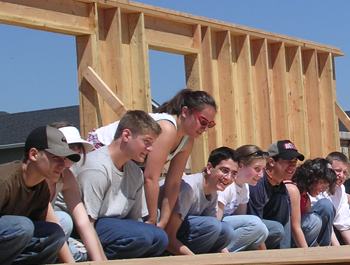Image

Merten Bangemann-Johnson, CEO, NeighborWorks Umpqua
Arthur Chaput, Director of Housing Rehabilitation
Challenge: Rural Oregon's single-family housing stock has deteriorated as the collapse of local industries and depressed rural wages take their toll. Traditional rehab resources are insufficient to meet demand. However, many homeowners have some of the skills, or at least the enthusiasm, necessary to perform their own repairs.
According to the American Housing Survey, problems with the quality of housing are most common in rural areas and central cities. That is in large part because poverty is high in rural areas, with 2012 data from the Housing Assistance Council showing that about 17.2 percent of rural residents living below the poverty line in 2012 versus 14.9 percent nationwide.
Meanwhile, funds for rural housing provided by the USDA via the 502 Direct Loan program—one of the primary government-aid programs for purchasing or rehabilitating homes in rural areas—have decreased over the past few years, dropping from about $2.1 billion in 2010 to around $828 million in 2013.
Another dynamic is that rural America is "older" than the nation as a whole, with more than one-quarter of all seniors living in rural and small town areas. Most seniors wish to remain and age in their homes as long as possible, but rural elders are increasingly experiencing challenges with housing quality as well as affordability. In far too many rural communities, the only housing options for seniors are their own homes, which are often difficult for them to maintain, or nursing homes, which have their own set of problems (including affordability).
In addition, the vast majority of rural seniors live in single-family units built in earlier decades when there was less awareness of what's required to ensure accessibility for people with all levels of physical abilities. A recent study published by AARP estimated that more than 1 million older adults with disabilities live in homes that present barriers to meeting their daily needs. Rehabilitation is a way for family members to help them stay at home.
 NeighborWorks Umpqua's Self-Help Housing Rehabilitation Program is designed to address these challenges. It is part of USDA Rural Development's 523 Mutual Self-Help initiative, which we have successfully redesigned to address the need for rehab, and financed in part by community development block grants and NeighborWorks America funds. We rehabilitated 70 homes in the last three years, improving the lives and preserving the assets of more than 150 individuals.
NeighborWorks Umpqua's Self-Help Housing Rehabilitation Program is designed to address these challenges. It is part of USDA Rural Development's 523 Mutual Self-Help initiative, which we have successfully redesigned to address the need for rehab, and financed in part by community development block grants and NeighborWorks America funds. We rehabilitated 70 homes in the last three years, improving the lives and preserving the assets of more than 150 individuals.Our program provides low- or zero-interest loans to low-income families whose homes need health- and safety-related repairs and who cannot qualify for other financing. Coupled with construction coaching and a tool library, this financing goes a long way—we replace leaking roofs, repair failed septic systems, install adequate heat sources and fix rotted flooring. Our program relies on the homeowners themselves to supply much of the labor: Many families put more than 40 hours a week into their rehab projects, often saving tens of thousands of dollars. Without our staff's tools and technical expertise, and without the support of the USDA Rural Development 523 program, these health and safety repairs would not be feasible, and many of these homes would exit the housing market through deterioration. Housing rehabilitation preserves housing affordability.
The bottom line: Homeowners, empowered with accessible financing and construction coaching, exit our program not just with a safe and durable home, but with skills and techniques that set them up for success in future home repair and maintenance. Furthermore, they can leverage these same skills in the job market. First-time homebuyers, too, have taken advantage of Self Help Housing Rehabilitation—often first-time buyers in our area can only afford homes in need of significant repair, and our rehab program enables them to build skills, equity, and a healthy home at the same time.
Mitchell Howard of Gold Beach, Oregon, is an example. "I knew the house needed some work when we bought it, and I had a plan for remodeling the kitchen," he told my team. "But the [termite] damage was so much more extensive than we thought. It was scary. We would have walked away from the house if you hadn't helped [us]." Now, the hidden damage is fixed, the home has new siding, and Mitchell is ready to tackle the kitchen remodel he had planned from the beginning. His new skills and confidence should ensure a smooth construction process.
Another example is Bill from Roseburg's Green District. NeighborWorks Umpqua helped replace his roof, reframe a rotten wall, replace a foundation wall, and gut and repair a rotten bathroom. The home was completely re-sided and every window was replaced, and Bill's old heat pump was repaired.
"I started walking months ahead to get in shape for this," said 74-year-old Bill. "I lost 20 pounds during the project!"
Bill did the vast majority of this work himself—with tools and technical assistance provided by NeighborWorks Umpqua—and saved an estimated $50,000 by doing so. NeighborWorks Umpuqa and the USDA Rural Development Self Help program kept Bill's family in their home, preserving another safe and affordable home.

